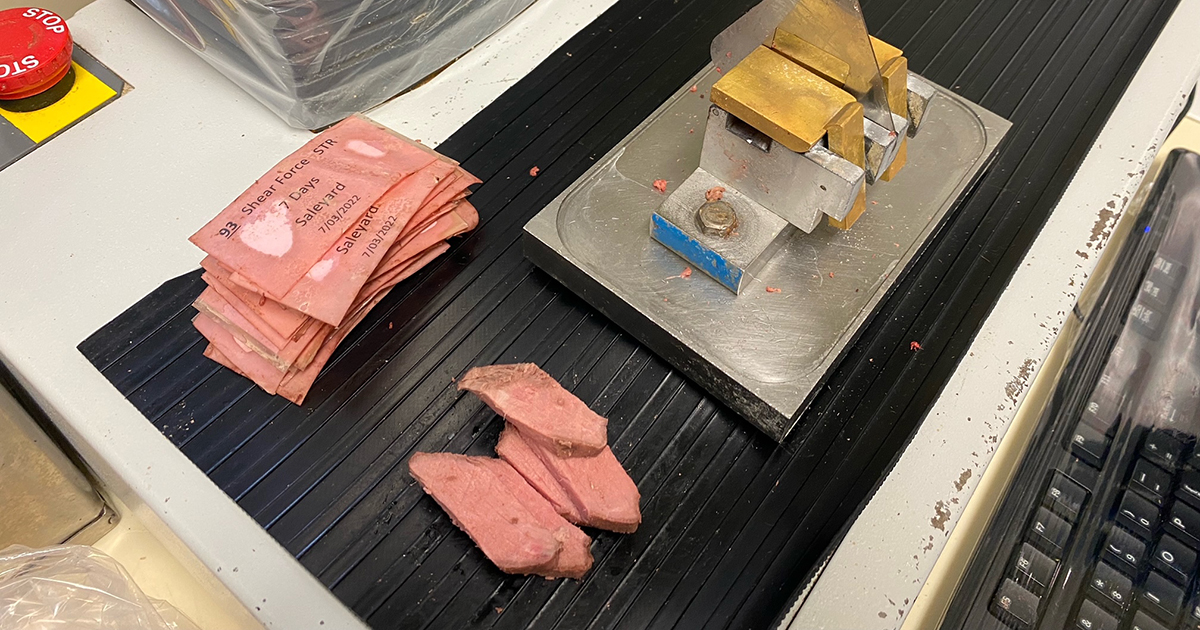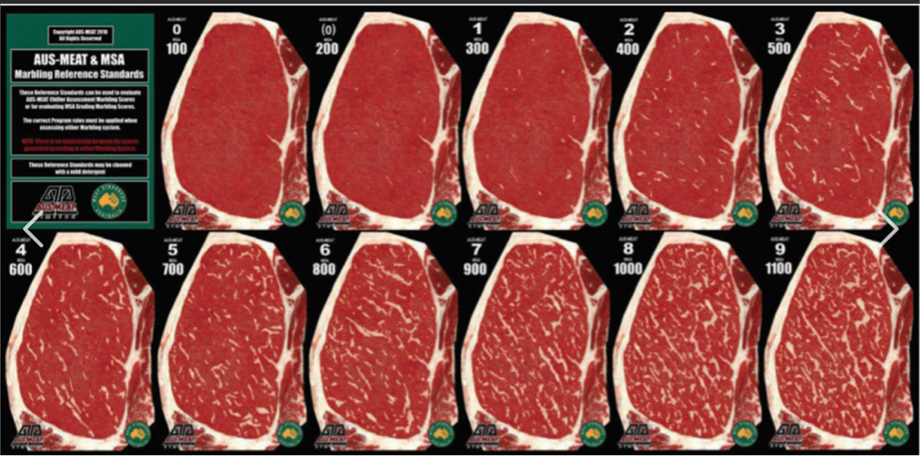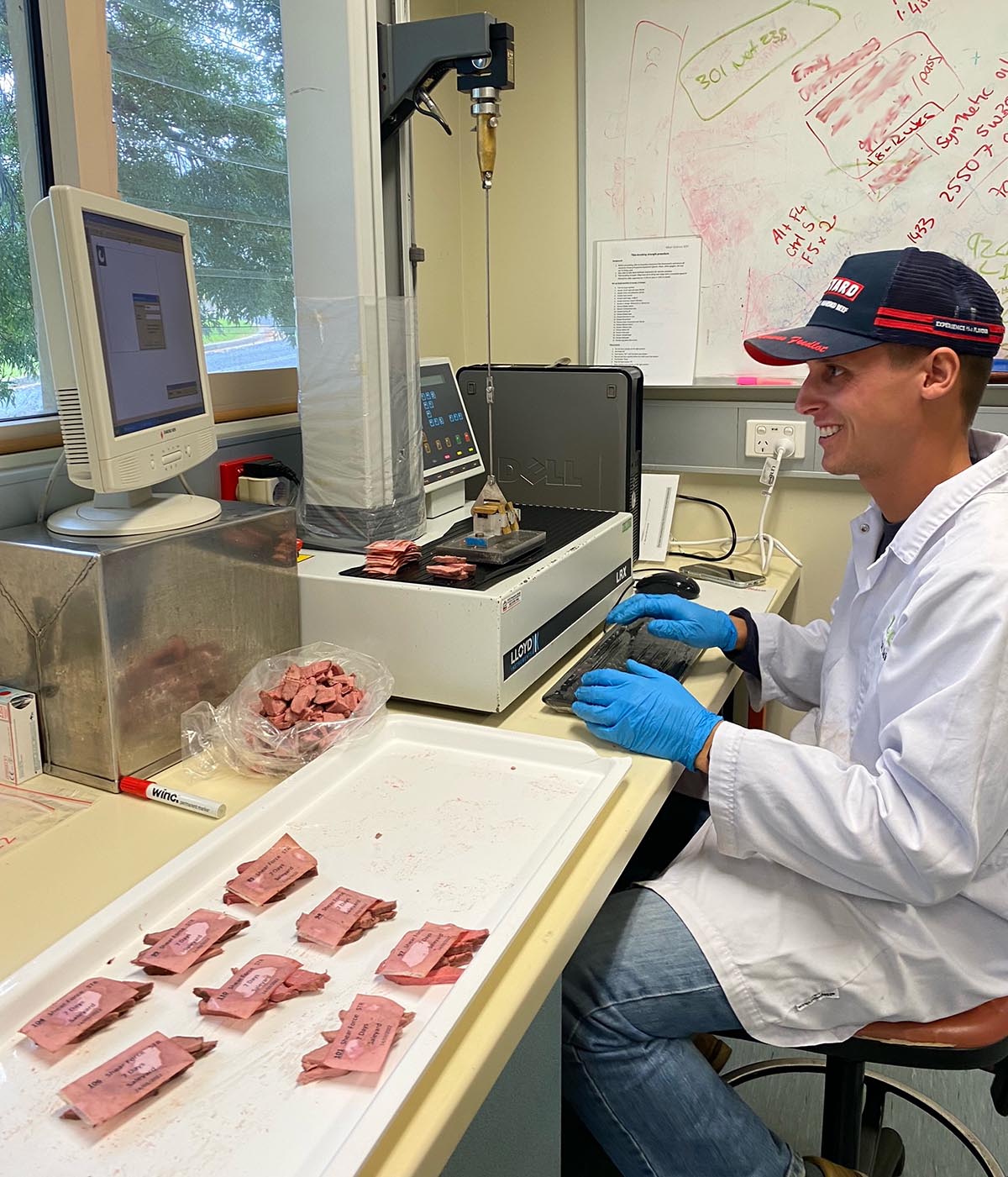Eating Quality Focus with New TACE Research Breeding Values


Two new Research Breeding Values (RBVs) are now available from the TransTasman Angus Cattle Evaluation (TACE), MSA Marbling Score and Shear Force.
“The new RBVs are a great addition to TACE as they allow Angus breeders to further focus selection decisions with the beef consumer in mind” says Christian Duff, Angus Australia’s General Manager Genetic Improvement.
For this outcome, Angus Australia partnered with the Animal Genetics and Breeding Unit (AGBU) and the Agricultural Business Research Institute (ABRI) to undertake the required genetic research. This was then implemented in the TACE EBV pipeline, underpinned by the BREEDPLAN model.
“The new RBVs are possible due to the dedicated recording of performance data, pedigree and genotypes from Angus Australia members, and Angus Australia initiatives such as the Angus Sire Benchmarking Program. For example, for MSA Marbling score, this now includes over 10,000 animals graded, with a high proportion also genotyped” Christian adds.
The two new RBVs join the growing suite of RBVs offered through TACE including Coat Type, ImmuneDEX, Mature Cow Body Condition and Mature Cow Height.
“RBVs are an important step in allowing early release of genetic information for new traits. This enables the refinement of both the performance recording information and the analytical models used in their calculation. Importantly, it also allows feedback from Angus Australia members and TACE EBV users prior to becoming a standard EBV” explains Christian.
MSA Marbling Score, being the subjective visual assessment of intramuscular fat at the chilled carcase grading site, has been identified as a trait of importance, particularly as it is related to Angus carcase value and consumer eating experience. It is also the commercially recognised method for describing marbling in the national grading system, Meat Standards Australia (MSA).
MSA Marbling Score RBVs are now routinely analyzed every two weeks in the TransTasman Angus Cattle Evaluation (TACE). This includes current and historic animals. To underpin this analysis, MSA marbling scores are utilised from both member collected data and from progeny in the Angus Sire Benchmarking Program. Angus animals, mostly steers, that are MSA graded between 300 and 1000 days of age at slaughter are included in the analysis.
MSA Marbling scores are collected using the industry standard 100 – 1100 grading system, with increments of 10 score unit (figure 1). A score of 100 indicates no/minimal marbling and a score of 1100 indicates abundant marbling. Along with the amount of marbling, the scores also take into account distribution and size of fleck (i.e. coarse or fine marbling).

Study of the Angus Australia data by AGBU has demonstrated that a significant portion of the differences in the MSA marbling score of individual animals can be attributed to genetics, having a high heritability of 0.54. The study also estimated the genetic correlation between MSA marbling score and a wide range of production traits included in the multi-trait analysis model utilized in TACE (from the BREEDPLAN program). As expected, the genetic correlations with carcase IMF, bull ultrasound scan IMF and heifer ultrasound scan IMF had the strongest relationship of 0.80, 0.35 and 0.35 respectively (figure 2).

From this collaborative research, Angus Australia now generates and publishes research breeding values for MSA Marbling Score. This information is available to select animals for use within Angus breeding programs with desirable genetics for this consumer-focused trait. This is underpinned by a large and growing reference population of MSA Marbling Scores (n>10,000 as of May 2023), coupled with genomic and pedigree data.
MSA Marbling Score (MMS) RBVs are estimates of genetic differences between animals in MSA marbling score at the 12/13th rib grading site in a 400 kg steer carcase.
MMS RBVs are calculated from MSA marbling scores (taken by a trained/accredited carcase grader), pedigree, genomics and correlated traits (e.g. Carcase IMF, bull and heifer ultrasound scan IMF). MMS EBVs are expressed in MSA marbling score units.
Higher, more positive MMS RBVs indicate the animal is expected to produce progeny with higher marbling scores in a 400 kg steer carcase.
The top 20 high use sires for MMS RBV are listed Table 1.
Shear force, the objective assessment of beef tenderness, has been identified as a trait of interest, as it is related to consumer eating experience.
Shear Force RBVs are now routinely analysed every two weeks in the TransTasman Angus Cattle Evaluation (TACE). This includes current and historic animals. To underpin this analysis, shear force measurements have been collected on beef samples from progeny in the Angus Sire Benchmarking Program. Angus animals, mostly steers, that are measured for shear force between 300 and 1000 days of age at slaughter are included in the analysis.
Shear force measurements were collected using the laboratory assessed warner bratzler (WB) method. This involves measuring the force (in kg) it takes to pull a blade through a piece of cooked meat (Figure 3). For this study, the samples are all collected from the Longissimus dorsi muscle at the 12th/13th rib grading site (i.e. cube role).

Study of the Angus Australia data by AGBU has demonstrated that a significant portion of the differences in beef shear force of individual animals can be attributed to genetics, having a moderate heritability of 0.37. Genetic correlations were not estimated due to the small current reference population size for this trait (n=1,169 as of May 2023).
From this collaborative research, couple with an initial reference population (phenotypes, genotypes and pedigree), it is now possible to generate breeding values for Shear Force and select animals for use within Angus breeding programs with desirable genetics for this trait.
Shear Force (SF) RBVs are estimates of genetic differences between animals in objective beef tenderness.
SF RBVs are calculated from laboratory assessed beef shear force measurements using the warner bratzler (WB) method, pedigree and genomics. SF EBVs are expressed in kilograms (kg) of shear force that are required to pull a mechanical blade through a piece of cooked meat.
Lower, more negative, SF EBVs indicates the animal is expected to produce progeny with less shear force required, and hence that their meat is more tender.
The top 20 high use sires for SF RBV are listed Table 2.
Research Breeding Values (RBVs) enable early access for Angus breeders to select animals with desirable genetics for MSA marbling score and Shear Force, balanced with selection for other traits of importance within their breeding objective.
RBVs are produced as part of the development of EBVs for new traits, which enable the refinement of both the performance recording information and the analytical software used in their calculation.
Research Breeding Values may change as enhancements are made to the analytical models, and as additional performance information is collected and analysed. This is particularly the case with the Shear Force RBVs due to the small current reference population size.
RBVs are published in two locations, the first being on the angus.tech online search facility. This provides the functionality to view the RBVs on individual animals or animal lists, along with the ability to search and sort through the Angus Australia database, like can be done for all published EBVs and Selection Indexes (Figure 4).

Additionally, a sire listing for each RBV is produced each quarter and made available on the Angus Australia website, from the Research page.
Angus Australia gratefully acknowledges the contributions of the Animal Genetics and Breeding Unit (AGBU) and the Agricultural Business Research Institute (ABRI), particularly Dr Gilbert Jeyaruban, Dr Steve Miller, Dr Natalie Connors, Dr Andrew Swan, Dr David Johnston and Dr Brad Crook, in the calculation of the new Research Breeding Values.
Angus Australia also acknowledges Meat and Livestock Australia (MLA) for the related R&D funding supplied to AGBU and Angus Australia for the ASBP. Also, for overseeing the MSA grading system, including the collection of MSA marbling scores in the ASBP, particularly through the grading by Janie Lau.
For the Shear Force data, Angus Australia also acknowledges the University of New England (UNE) Meat Science team particularly Dr Peter McGilchrist and Xuemei Han.
If you have any questions about the MSA Marbling or Shear Force RBVs please contact our Genetic Improvement or Extension personnel:
Jake Phillips – Extension Manager, Mobile: 0401 261 217, Email: jake.phillips@angusaustralia.com.au
Nancy Crawshaw – Extension Officer, Mobile: 043 633 7652, Email: nancy.crawshaw@angusaustralia.com.au
Jen Peart – Acting Genetic Improvement Specialist, Mobile: 0417 219 405, Email: jen.peart@angusaustralia.com.au
Christian Duff – General Manager Genetic Improvement., Mobile: 0457 457 141. Email: christian@angusaustralia.com.au